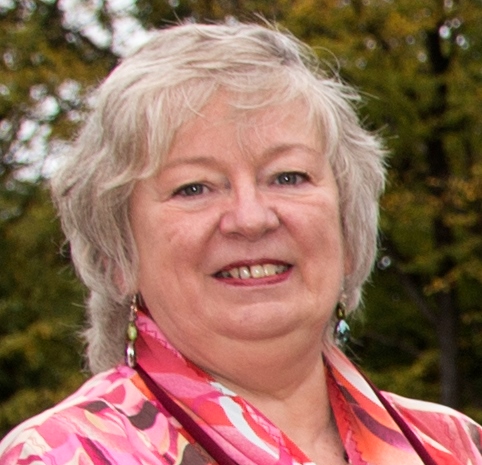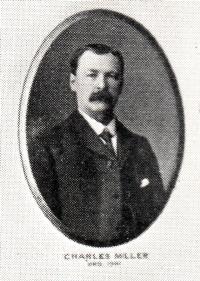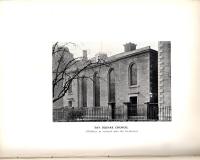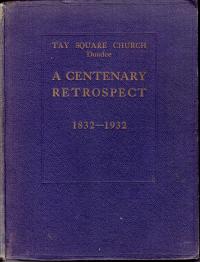- Birth*: Charles Milne Miller was born on 17 March 1864 at Dundee, Angus, Scotland,
 .1
.1 - He was the son of James Miller jute warehouseman and Janet Milne.
- (Groom) Marriage*: Charles Milne Miller married Betsy Low, daughter of Robert Low and Janet Gray, on 3 July 1891 at 12 Clarendon Terrace, Dundee, Forfarshire, Scotland,
 ; 1891 marriages in the district of St Peter in the burgh of Dundee, ref 132; 1891 on the third day of July at 12 Clarendon Terrace Dundee after publication according to the forms of the U P Church; signed Charles M Miller hacklemaker bachelor aged 27 residing 166 Scouringburn Dundee, parents James Miller warehouseham (dec) and Janet Miller ms Mill; signed Betsey Low jute weaver spinster aged 24 residing 32 Main Street Dundee, parents Robert Low bookmaker (dec) and Janet Low ms Gray (dec); signed John Reid MA minister Tay Square Church Dundee, signed John White & Jessie Miller witnesses; registered 1891 July 7th at Dundee Dav Young assist registrar.2
; 1891 marriages in the district of St Peter in the burgh of Dundee, ref 132; 1891 on the third day of July at 12 Clarendon Terrace Dundee after publication according to the forms of the U P Church; signed Charles M Miller hacklemaker bachelor aged 27 residing 166 Scouringburn Dundee, parents James Miller warehouseham (dec) and Janet Miller ms Mill; signed Betsey Low jute weaver spinster aged 24 residing 32 Main Street Dundee, parents Robert Low bookmaker (dec) and Janet Low ms Gray (dec); signed John Reid MA minister Tay Square Church Dundee, signed John White & Jessie Miller witnesses; registered 1891 July 7th at Dundee Dav Young assist registrar.2 - (Deceased) Death*: Charles Milne Miller died on 7 November 1951 at Maryfield Hospital, Dundee, Angus, Scotland,
 , at age 87 1951 deaths in the distrtict of St Andrew in the burgh of Dundee, ref 702, Charles Milne Miller hacklemaker retired widower of Betsy Low, 1951 November seventh 8h 0m pm Maryfield Hospital Dundee ur 28 Barnes Avenue, male aged 87 years, parents James Miller jute warehouseman (dec) and Janet Miller ms Milne (dec), fractures of ninth rib on the right, fracture of the symphysis pubis, traumatic shock as cert by Matthew H Robertson MBChB, signed R M Low nephew 28 Barnes Avenue Dundee, registered 1951 November 8th at Dundee Norman Steele registrar.3
, at age 87 1951 deaths in the distrtict of St Andrew in the burgh of Dundee, ref 702, Charles Milne Miller hacklemaker retired widower of Betsy Low, 1951 November seventh 8h 0m pm Maryfield Hospital Dundee ur 28 Barnes Avenue, male aged 87 years, parents James Miller jute warehouseman (dec) and Janet Miller ms Milne (dec), fractures of ninth rib on the right, fracture of the symphysis pubis, traumatic shock as cert by Matthew H Robertson MBChB, signed R M Low nephew 28 Barnes Avenue Dundee, registered 1951 November 8th at Dundee Norman Steele registrar.3 - (Deceased) Death RCE: His death registration was corrected on 5 December 1951 at Maryfield Hospital, Dundee, Angus, Scotland,
 , Vol XXII page 77 Register of Corrected Entries for the district of St Andrew in the burgh of Dundee. The following Report of Res... of a Precognition has been received touching the death of Charles Milne Miller, registered under entry 702 in the Register Book of Deaths for the year 1951.
, Vol XXII page 77 Register of Corrected Entries for the district of St Andrew in the burgh of Dundee. The following Report of Res... of a Precognition has been received touching the death of Charles Milne Miller, registered under entry 702 in the Register Book of Deaths for the year 1951.
Charles Milne Miller, male, 87 years, dies at 8pm on 7th November 1951 at Maryfield Hospital Dundee ur 28 Barnes Avenue Dundee, fractures of ninth rib on the right, fracture of the symphysis pubis, traumatic shock as cert be Matthew H Robertson MBChB Maryfield Hospital Dundee, certified by signed James Clark Procurator Fiscal, Procurator Fiscal's Office Dundee 5th December 1951, James D Clark asst registrar initialled NS regr 6th December 1951 at Dundee
signed R M Low nephew 28 Barnes Avenue Dundee, registered 1951 November 8th at Dundee Norman Steele registrar.4 - Occupation*: Charles was was a hacklemaker.
- (Informant) Death: He registered the death of Betsy Low on 5 November 1948 at Sheherd's Buildings, Abernethy, Perthshire, Scotland,
 ; 1948 deaths in the district of Abernethy in the county of Perth, ref 9; Betsy Miller married to Charles Miller hacklemaker retires, 1948 November fifth 0h 45m am Shepherd's Buildings Abernethy, female aged 82 years, parents Robert Low constable (dec) and Janet Low ms Gray (dec); congestive heart failure as certified William L Tullis MD Newburgh; signed Charles Miller sidower present; registered 1948 November 5th at Abernethy George Ritchie registrar.5
; 1948 deaths in the district of Abernethy in the county of Perth, ref 9; Betsy Miller married to Charles Miller hacklemaker retires, 1948 November fifth 0h 45m am Shepherd's Buildings Abernethy, female aged 82 years, parents Robert Low constable (dec) and Janet Low ms Gray (dec); congestive heart failure as certified William L Tullis MD Newburgh; signed Charles Miller sidower present; registered 1948 November 5th at Abernethy George Ritchie registrar.5 - (Witness) History: The Gazetteer of Scotland published by W Chalmers in 1803 gives this description of the Parish of Liff, Benvie and Invergowrie : The united parishes are about 3 miles in length and nearly the same breadth. The surface rises with an easy ascent from the Tay, except towards the south west where it joins to the parish of Dundee. The higher ground forms a ridge, stretching obliquely in a direction from East to West, and behind is an extensive tract of muir, where there are some plantations, but no marks of cultivation. The muir is bounded by the water of the Dichty, which rises in the parish of Lundie, and runs south and east through the valley of Strathmartin. There are several villages, viz, Locheye, Millhouse, Liff, Benvie and Invergowrie: the latter is noted as the site of the first Christian church erected on the north side of the river Tay.
The first Statistical Account of Scotland for the parish of “Liff and Bervie (sic)” written around 1792 by the then incumbent of the parish church, the Rev. Mr Thomas Constable, describes the parish in great detail. He states that the union of the parishes of Liff and Bervie happened in November 1758 and that Liff comprehended the old parishes of Logie and Invergowrie; both of which, as appears from the records of the kirk-session, were united to it before the middle of last century (which of course was sometime during the 17th century). From his descriptions, it seems that the amalgamated parish included parts of Lochee (written then as Locheye, although the pronunciation probably hasn’t changed) and Balgay Hill. Describing the land to the east of Balgay Hill he says it is either wholly planted or cultivated, and a low narrow dale, extending from thence westward through the village of Bervie …Along this agreeable exposure, are interspersed houses, trees, and fields in culture. Talking of the watercourses in the parish he describes the burn of Invergowrie, and here, in the months of March and April, sea-trout are sometimes found of 4lbs weight.
Commenting on the population, the Rev Constable notes that in cases of marriage here, it often happens, that the man is far less advanced in life than the woman he marries. The former depends much on the experience of the latter, and generally too on the savings of her industry, to enable him to begin with some comfort a married life: This disparity of years happening on the side of the woman, must needs be a hinderance to population. And in a footnote he continues The register of baptisms … is not to be considered as giving an accurate account of the births in it. Children that are still-born, or die unbaptized are never mentioned in the public register; besides there are parents, who sometimes from neglect, and sometime from parsimony, do not insert in it their childrens’ names, and by Dissenters this duty is often omitted entirely. He is equally critical of the recording of deaths – particularly due to a perceived rivalry over mortcloths with the church at Logie in the neighbouring parish of Dundee!
There then follows lengthy discourse on the state of the land, the methods employed in the agriculture of the time, the prices paid for horses for the plough and the numbers of “milch cows”. The areas described as Locheye and Milehouse (so called to mark the distance from Dundee) seems to have housed various manufacturers, mainly of the course linens, known from their breadth as “yard wides” and “three quarter wides”.
Familiar place and road names pop up throughout the text – Pitalpin ; known then as Pitalpie or Pit of Alpin and ascribed to being the scene of a memorable engagement in the 9th century between the Picts and Scots in which the latter were routed and Alpin their king slain. Apparently the king’s head was transported to Abernethy for public viewing, but his body was buried at Pitalpie. On top of a small hill east of Pitalpie there was still visible a stone called the King’s Cross.
The parochial school averaged 35 scholars, but it was noted that it was extremely difficult for the children to attend during the winter months as the roads were almost impassable. It appears that this was viewed by Mr Constable as a meagre school roll and he states the whole emoluments are too inconsiderable for a teacher of any merit or capacity. And he regarded the five private schools as for the most part indifferently taught. The poor did not seem the cause any major difficulty, seeming to have been provided for in the usual way from the income of the church from mortcloth hiring, proclamations of marriage, rents of a few seats in the church and collections at the church door.
In the Second Statistical Account written in September 1842 by the Rev. George Addison, DD, minister of the parish of Liff and Benvie we find some clarification (and disagreement with the Gazetteer of earlier years – or maybe there were further boundary changes) of the extent of the parish. He admits that the lands of Logie, Balgay and Blackness are indeed part of the parish and that a considerable portion of the suburbs of Dundee to the west and north is built on these lands. But dismisses unreservedly the inhabitants of the parish of Logie … as … having, from time immemorial, been connected with Dundee, quoad spiritualia, it will not be necessary to take any further notice of this part of the united parish! He also notes that for nearly two centuries the minister of Dundee had received an annual payment of twelve bolls of barley … expressly for the sacraments and marriage to the heritors and inhabitants of the lands of Balgay and Logie, and the lands of Blackness. Mr Addison describes the parish as situated at the south-west corner of the county of Forfar, being bounded on the west by the parishes of Fowlis Easter and Longforgan (both in Perthshire) on the on the South, by the river Tay; on the east, by Dundee and the United parish of Mains and Strathmartine; and on the north, by the Dighty, a small river which divides it from the parishes of Auctherhouse and Lundie. The extent is about 6 miles from east to west, and 4 miles from north to south. … There is no river in the parish. … Near the village of Benvie is a spring strongly impregnated with iron. It was formerly in great repute as a tonic, and was applied externally in cutaneous disorders, but is now entirely neglected.
There is tremendous discussion of the geology of the area, involving red and gray sandstone and a discovery of fossil organic remains in the den of Balruddery by Mr Webster, the proprietor. It is noted that there is nothing very peculiar or rare in the botany of this parish … but … the romantic dells and glens which abound in this neighbourhood are, in the season, richly clothed with the most beautiful plants and flowers.
There are four mansion houses briefly described – the House of Gray (owned by the Rt Hon Lord Gray), Camperdown House (the Rt Hon Earl of Camperdown), the mansion house at Invergowrie (Alexander Clayhills, Esq) and Balruddery House (Robert Webster, Esq). Other land-owners are noted as Frederick Lewis Scrimgeour Wedderburn, Esq. of Wedderburn and Birkhill, William Henderson, Esq. Of Mylnefield, Mr Thomas Watson, Liff and Mr James Waddel.
The population is discussed and from this it is apparent that some form of census was taken at irregular intervals from the middle eighteenth century, if not earlier. Genealogists are aware of nation-wide 10-yearly censuses taken from 1801, but are advised that the first one of any real benefit to them is the 1841 census. But it is interesting to read that the wrangle over the village of Lochee continues … that village now being politically connected with Dundee, or within the Parliamentary boundary, the population at the last census (June 1841) was taken in connection with Dundee, and not with this parish. On that account, the precise amount of the inhabitants of Lochee is not known to me; but it cannot be under 3000 souls. Mr Addison, in his concern with the moral and secular welfare of the parish, notes that seven illegitimate children were born within the parish in the previous three years, but in most cases the parents married afterwards; that three of the patients in the Dundee Lunatic Asylum are parishioners, as is one in the care of a family at the expense of the kirk-session and five by their relations; and that a brother and sister are deaf and dumb. He generously states that the character of the people is by and large peaceable and industrious, and, with a few marked exceptions, sober.
As to manufacture – Within the last sixteen or seventeen years, three spinning mills have been erected in the village of Lochee, and one at Denmiln, in the parish. Whatever advantages may accrue from these establishments, they have a very unfortunate effect on the morals and pauperism of the community. The chief, if not sole, product was coarse linen, principally for exportation, which had supplanted the weaving of household linen. Hand-spinning was almost obsolete. Many employed in the spinning and weaving found they had to supplement their income with agricultural employment when they could get it, mainly in spring and at the harvest time. Addison estimates that around 2000 folk in Lochee were employed in manufacture at this time and comments … The depressed state of the linen trade, for some time past, has been severely felt by the operatives in this quarter. Many families have, in consequence, been brought to a state of indigence and destitution. But he states elsewhere … At Bullion, near Invergowrie, an extensive work for bleaching and dying yarn and cloth has lately been established. The necessary erections have been made with great care, and at considerable expense. There is on the premises a water-wheel of 14 horses’ power, and a steam-engine of 6. A gasometer has been fitted up solely for the use of the work.
For the farmers, trade was brisk with near-by Dundee. Weavers and the like were persuaded by low feus to take up Mr Wedderburn of Birkhill’s offer of small portions of land on the turnpike road to Meigle and Coupar-Angus giving them a convenient location for their trade.
In about 1830, at last the parochial school was moved to a far better, but undisclosed, location (the writer assumes all readers will know where it is (the present spot)!) but it was recognised that having the school at Denmiln was most inconvenient and almost inaccessible in winter. Another school was built, in the questionable Lochee, in 1837. The year before the Account was written, a “school of industry” for young females was initiated under the patronage of Countess of Camperdown. In total, about 500 children were receiving education of some sort in the parish at this time.
Mr Addison describes his concern over the steep rise in pauperism, with the need in 1841 to recourse to a legal method of assessment. Including the upkeep of the inmates of the Lunatic Asylum and the fatherless babies, he indicates that 49 folk required some sort of aid, with an average of 7 shillings per head per month spent. He is critical of the apparent moneygrubbing attitude that prevailed, and in particular, the difficulty of bringing absent fathers to account – nothing in this world is new!
His last comments support the recurring theme of “bad Lochee”! The number of public-houses in the parish of Liff proper is four, situated generally at considerable distances from each other. In Lochee there are at least twelve, including shops where spirits are sold, both in and out of doors. Poor old degenerate Lochee!12,13,14 - (Witness) History: Five into One –Tay Square Church. Tay Square traces its origins to the secessions of the eighteenth century. From 1743, School Wynd Secession Church flourished, but in 1832, a group of members, dissatisfied over the nomination of a new minister, disjoined to form Tay Square United Secession Church, entering their new church in 1834. Rev. Robert Wardrope, 1807-1840 was called in 1832 to be minister of School Wynd Church, but in consequence of a dispute in that congregation the call was not sustained. Those who supported him left the church, and were formed into a separate congregation —Tay Square —and they at once called Mr Wardrope, but his delicate health prevented his acceptance of the call. He died when only 33 years of age. Still in the church archives, this silhouette of Rev. Robert Wardrope was lent by its owner, Andrew Roxburgh, to be exhibited in the “Old Dundee” exhibition of 1892-93 –held in the Albert Institute (now McManus Galleries).
The first minister, the Rev. J R McGavin, was elected in 1875 as Moderator of the United Presbyterian Synod. The second, the Rev. Dr Charles Jerdan, became Principal Clerk of the United Free Church General Assembly. Under these two ministers, Tay Square became one of the foremost congregations in the United Presbyterian Church. Mission activities centred on the West Port, Artillery Lane and Hawkhill, the last leading to the founding in 1876 of Hawkhill United Presbyterian Church, which united with Tay Square in 1903.
Such community interests were extended onto a national scale by the Rev. John Mansie, who as Convener of the Assembly Committee on Social Problems, was largely responsible for the establishment in 1931 of the Belmont Castle Eventide Home. After the union of Tay Square and St. Paul's in 1952, the Tay Square building was reopened as St. Paul's Halls by Mrs Jarvis, wife of the Very Rev. Ernest D Jarvis and daughter of the Rev. John Reid, a former Tay Square minister.
© Meadowside St. Paul’s 2017. All rights reserved.15 - [S1] International Genealogical Index (IGI) (Salt Lake City, Utah, USA: International Genealogical Index), C112821.
- [S64] General Record Office for Scotland, online www.scotlandspeople.gov.uk, General Record Office for Scotland (Edinburgh, Scotland), GROS statutory marriages 1891 St Peter Dundee ref 0132 image held [June 2004].
- [S50] General Record Office for Scotland, online www.scotlandspeople.gov.uk, General Record Office for Scotland (Edinburgh, Scotland), GROS statutory death 1951 St Andrew Dundee ref 702 image held [June 2004].
- [S50] General Record Office for Scotland, GROS statutory death RCE 1951 St Andrew Dundee ref 702 image held [Sep 2011].
- [S50] General Record Office for Scotland, GROS statutory death 1948 Abernethy Perthshire ref 9 image held [Sep 2011].
- [S17] General Record Office for Scotland, online www.scotlandspeople.gov.uk, General Record Office for Scotland (Edinburgh, Scotland), GROS census 1871 Liff & Benvie [May 2004].
- [S17] General Record Office for Scotland, 1881 British Census, 166 Souringburn, Liff & Benvie, Forfar, Scotland 0203482 282-2 17 24.
- [S9] Website Ancestry.co.uk (www.ancestry.co.uk) Source Citation: Parish: Liff and Benvie; ED: 17; Page: 24; Line: 13; Roll: cssct1881_83; Year: 1881. Source Information: Ancestry.com. 1881 Scotland Census [database on-line]. Provo, UT, USA: Ancestry.com Operations Inc, 2007. Original data: Scotland. 1881 Scotland Census. Reels 1-338. General Register Office for Scotland, Edinburgh, Scotland. [May 2011]
- [S17] General Record Office for Scotland, GROS census 1891 Liff & Benvie, Dundee [May 2004].
- [S37] Directory Dundee (Dundee:, Dundee Directory 1895-6 [Mar 2014]. Hereinafter cited as Dundee Directory.
- [S9] Website Ancestry.co.uk (www.ancestry.co.uk) Source Citation: Parish: Liff and Benvie; ED: 19; Page: 2; Line: 7; Roll: CSSCT1901_94; Year: 1901. Source Information: Ancestry.com. 1901 Scotland Census [database on-line]. Provo, UT, USA: Ancestry.com Operations Inc, 2007. Original data: Scotland. 1901 Scotland Census. Reels 1-446. General Register Office for Scotland, Edinburgh, Scotland. [Sep 2011]
- [S49] Website Web Site online (www.) http://www.genuki.org.uk/node/98277.
- [S49] Website Web Site online (www.) http://stataccscot.edina.ac.uk/static/statacc/app/index.html#/viewer/osa-vol13-Parish_record_for_Liff_and_Benvie_in_the_county_of_Forfar_in_volume_13_of_account_1/?search=liff
- [S49] Website Web Site online (www.) http://stataccscot.edina.ac.uk/static/statacc/app/index.html#/viewer/nsa-vol11-Parish_record_for_Liff_and_Benvie_in_the_county_of_Forfar_in_volume_11_of_account_2/?search=liff
- [S49] Website Web Site online (www.) https://www.mspdundee.co.uk/publications
https://docs.wixstatic.com/ugd/5b5054_7424373caf2f49c5ad634cfc70fb4474.pdf
https://docs.wixstatic.com/ugd/5b5054_4efe5d38a65442948fd3e5ad25a55cf3.pdf [May 2019].
Charles Milne Miller
M, #474, b. 17 March 1864, d. 7 November 1951
Last Edited: 16 Aug 2018
Parents:
Father*: James Miller jute warehouseman b. 23 May 1817, d. 14 Jun 1881
Mother*: Janet Milne b. 22 Dec 1823, d. 6 Jun 1896
Mother*: Janet Milne b. 22 Dec 1823, d. 6 Jun 1896
Relationship:
2nd great-uncle of Patricia Catherine Adamson
Notes
Citations
Charts:
Anderson, John c1733 descendants
Bruce, Elizabeth c1733 descendants
Matthew, James c1765 descendants
Miller, Patrick/Peter c1749 descendants
Milne, James c1765 descendants
Paterson, Agnes c1765 descendants
Robertson, David c1740 descendants
Stephen, Janet c1750 descendants
Urquhartson, Elisabeth s1735 descendants
Bruce, Elizabeth c1733 descendants
Matthew, James c1765 descendants
Miller, Patrick/Peter c1749 descendants
Milne, James c1765 descendants
Paterson, Agnes c1765 descendants
Robertson, David c1740 descendants
Stephen, Janet c1750 descendants
Urquhartson, Elisabeth s1735 descendants
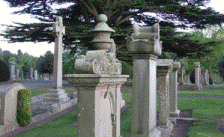 Genes on the Web
Genes on the Web